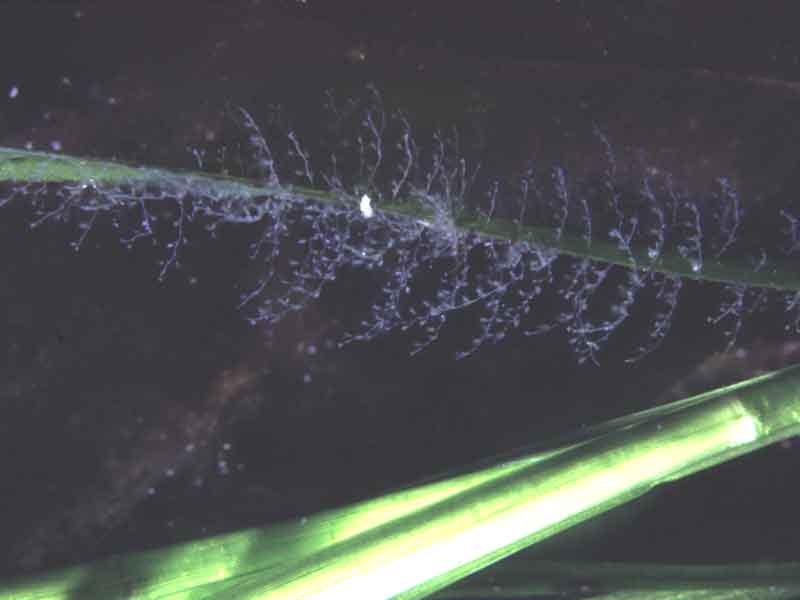Seagrass sea fir (Laomedea angulata)
Distribution data supplied by the Ocean Biodiversity Information System (OBIS). To interrogate UK data visit the NBN Atlas.Map Help
| Researched by | Emily Wilson | Refereed by | Admin |
| Authority | Hincks, 1861 | ||
| Other common names | - | Synonyms | - |
Summary
Description
Recorded distribution in Britain and Ireland
Recorded mainly from southern England and a few locations in Ireland.Global distribution
Recorded from the northern shores of the Mediterranean north to England and the Netherlands (Cornelius, 1995b).Habitat
Recorded only on eel grasses to about 8 m depth.Depth range
-Identifying features
- Colonial, forming short shoots arising from straight stolon.
- Internodes almost straight.
- Hydrothecae on long, ringed pedicel.
- Gonothecae on stolon; long-ovoid; aperture terminal, narrow.
Additional information
Apparently confined to the seagrass Zostera marina in southern England where it can withstand salinity at least as low as 17.7 psu (Cornelius, 1995b). Cornelius (1995b) notes that there have been few British records since the decimation of British eel-grass during the 1930's. The records from Belfast Lough and the Isle of Man are from the 19th century. Most records on the distribution map are from MNCR and BioMar surveys (JNCC, 1999). However, records from the Menai Strait and from Clovelly have not been included and are considered dubious. A record from Skomer (Crothers, 1966) is considered dubious by Cornelius (1995b).Listed by
- none -
Bibliography
Bruce, J.R., Colman, J.S. & Jones, N.S., 1963. Marine fauna of the Isle of Man. Liverpool: Liverpool University Press.
Cornelius, P.F.S., 1995b. North-west European thecate hydroids and their medusae. Part 2. Sertulariidae to Campanulariidae. Shrewsbury: Field Studies Council. [Synopses of the British Fauna no. 50]
Crothers, J.H. (ed.), 1966. Dale Fort Marine Fauna. London: Field Studies Council.
Hayward, P.J. & Ryland, J.S. (ed.) 1995b. Handbook of the marine fauna of North-West Europe. Oxford: Oxford University Press.
Howson, C.M. & Picton, B.E., 1997. The species directory of the marine fauna and flora of the British Isles and surrounding seas. Belfast: Ulster Museum. [Ulster Museum publication, no. 276.]
JNCC (Joint Nature Conservation Committee), 1999. Marine Environment Resource Mapping And Information Database (MERMAID): Marine Nature Conservation Review Survey Database. [on-line] http://www.jncc.gov.uk/mermaid
Datasets
NBN (National Biodiversity Network) Atlas. Available from: https://www.nbnatlas.org.
OBIS (Ocean Biodiversity Information System), 2024. Global map of species distribution using gridded data. Available from: Ocean Biogeographic Information System. www.iobis.org. Accessed: 2024-05-19
Citation
This review can be cited as:
Last Updated: 17/09/2002



